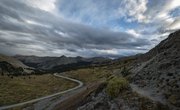
The word “tundra” comes from a Lappish word meaning “treeless land” or “barren land”. Most of the tundra biome’s 3.3 million square miles is located in the Arctic region of the world, above the northernmost limit for tree growth.
Even though the tundra landscape is defined by rhythmic freezing and thawing, it still supports an extensive array of wildlife and vegetation. This post will go over the tundra definition as well as details of what to expect in the tundra.
Tundra Definition
Before we get into the details of the tundra's landscape, let's define it. The tundra definition according to UC Berkeley includes the following characteristics:
- Extremely cold (coldest biome on Earth). Average winter temperature at -30 degrees C
- Low biotic diversity. (Limited because of lack of rainfall, permafrost, etc)
- Simple vegetation structures. Low roots, only in topsoil because of permafrost, etc
- Limited drainage possible.
- Extremely short season of growth and reproduction. Growing season usually 50-60 days long.
- Energy and nutrients come mostly from dead plants and animals.
- Limited rainfall/precipitation. Average rainfall is 6-10 inches
Locations
The arctic tundra comprises the majority of the tundra landscape in the world, with 2 million square miles in North America and 1.3 million square miles in Eurasia. The North American tundra begins with coastal Greenland, goes west through northern Canada and extends all the way through northern Alaska. Tundra in Eurasia covers Siberia, parts of Russia, northern Scandinavia and Iceland.
A second type of tundra, called alpine tundra, exists on high-altitude mountaintops throughout the world. Mt. Rainier National Park in Washington is one example of alpine tundra.
Permafrost Zones
The tundra landscape is broken up into three distinct zones. The climate in each zone greatly impacts the landscape, vegetation and animal life that exists there.
The permanent permafrost zone is centered at the North Pole and spreads outward to the arctic circle, northern Greenland, and the northernmost part of North America. This landscape never thaws.
The next zone—semi-permanent permafrost—accounts for more than a third of the tundra biome. During the region’s short summer, the top layer of soil thaws for long enough to support insect, animal and vegetal life.
Further south lies the sporadic permafrost zone, which is about as large as the semi-permanent region. There, land freezes less often and the thaw goes deeper into the soil, resulting in a wider variety of life. This zone also has poor soil drainage due to its permafrost layer and supports very few trees.
Periglacial Landforms
“Periglacial landforms are those features that develop under the action of hard frosts, often in permafrost conditions,” states the Smithsonian Institute’s book “Earth.” The arctic tundra is filled with periglacial landforms, including pingos, ice wedges, ice lenses, and block fields.
Pingos are small hills resulting from ice—trapped between layers of soil and rock—which heaves and bulges the land up into a mound. Ice wedges are similarly made, but rather than forming mounds, the wedges are unusually-shaped ice masses.
Ice lenses occur when ice trapped in soil sinks, developing a convex exterior. Block fields are the result of large sedimentary rock walls breaking down into fields of rubble after excessive freezing and thawing.
Vegetation
Vegetation found in arctic and alpine tundra include moss, lichen, several varieties of grasses and flowers and low-lying shrubs. Because of arctic tundra’s layer of poorly draining permafrost, plant growth is limited to the active layer of topsoil, where standing water and bogs also easily form with precipitation.
Both arctic and alpine tundra are characterized by their inability to support trees, but the soil of alpine tundra is more well-drained because it lacks the permafrost layer. The annual freezing and thawing of the arctic tundra results in geometrically patterned plant growth, most easily seen from the air.
Tundra Animals
The tundra animals found in the tundra landscape are well-adapted to it. Most tundra animals hibernate in the winter and mate and raise their offspring during the short summer. The great majority of tundra birds live there only in the summer, migrating south for the winter.
Some animals, like squirrels, caribou, arctic hares, lemmings, musk ox and voles eat only plants. Other animals, such as polar bears, arctic foxes and wolves are carnivorous. Cod, salmon and trout make their way into waters of the tundra.
Bird species include ravens, loons, penguins, falcons and various gulls. With ample standing water in the summertime, even mosquitoes have adapted to the tundra.
References
- “Smithsonian Institution: Earth”; James F. Luhr, editor-in-chief; 2007
- University of California Museum of Paleontology: The Tundra Biome
- World Biomes: Tundra Biomes
About the Author
Based just outside Chicago, Meg Campbell has worked in the fitness industry since 1997. She’s been writing health-related articles since 2010, focusing primarily on diet and nutrition. Campbell divides her time between her hometown and Buenos Aires, Argentina.
Photo Credits
Arctic tundra image by gburba from Fotolia.com
